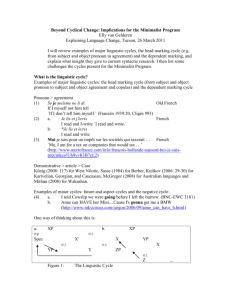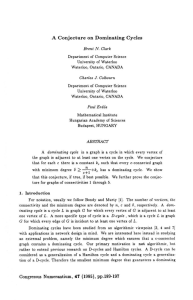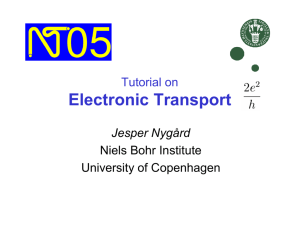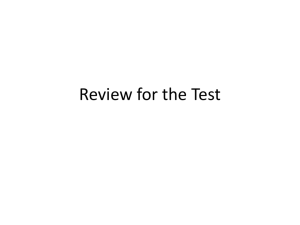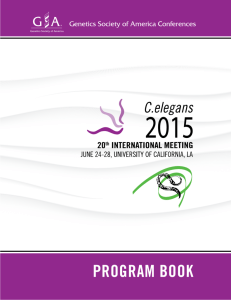AP Biology 1ST Semester Exam Review 45 min: Multiple Choice (30
advertisement
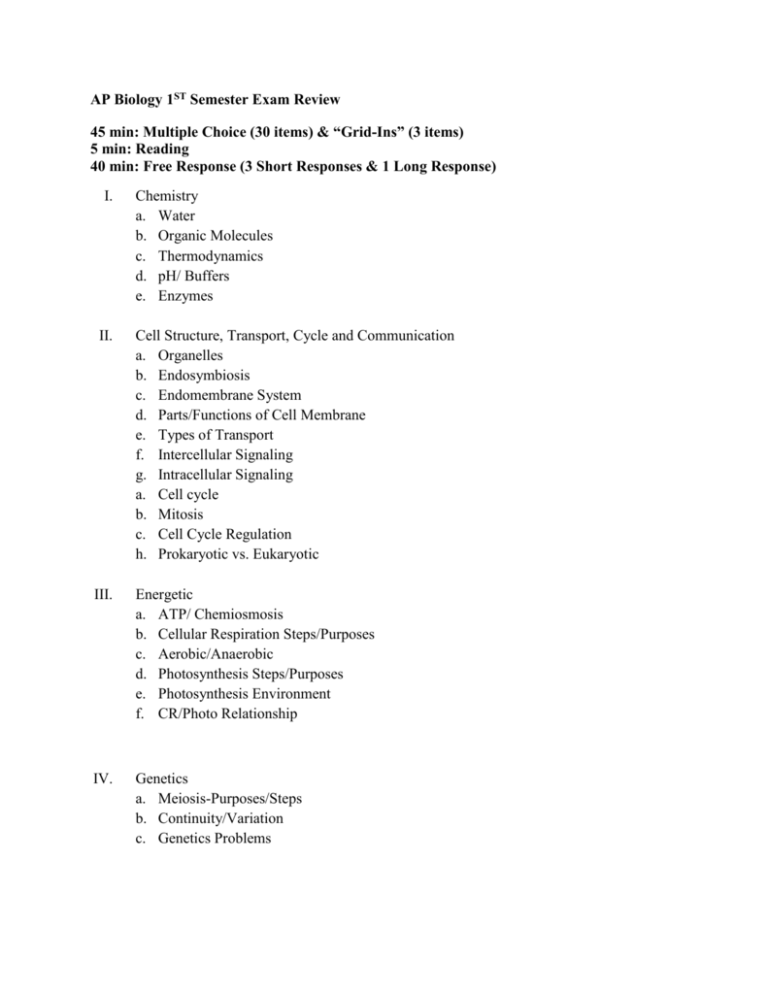
AP Biology 1ST Semester Exam Review 45 min: Multiple Choice (30 items) & “Grid-Ins” (3 items) 5 min: Reading 40 min: Free Response (3 Short Responses & 1 Long Response) I. II. Chemistry a. Water b. Organic Molecules c. Thermodynamics d. pH/ Buffers e. Enzymes Cell Structure, Transport, Cycle and Communication a. Organelles b. Endosymbiosis c. Endomembrane System d. Parts/Functions of Cell Membrane e. Types of Transport f. Intercellular Signaling g. Intracellular Signaling a. Cell cycle b. Mitosis c. Cell Cycle Regulation h. Prokaryotic vs. Eukaryotic III. Energetic a. ATP/ Chemiosmosis b. Cellular Respiration Steps/Purposes c. Aerobic/Anaerobic d. Photosynthesis Steps/Purposes e. Photosynthesis Environment f. CR/Photo Relationship IV. Genetics a. Meiosis-Purposes/Steps b. Continuity/Variation c. Genetics Problems Vocabulary Polar Hydrogen bond Covalent bond Van der Waals bond Cohesion/Adhesion Surface tension Specific heat Heat of vaporization Evaporative cooling Solvent C skeleton Functional groups Isotopes 1st and 2nd Laws of Thermodynamics Exergonic/Endergonic pH Acid/Base Buffer Polymer/Dehydration reaction Mono/Di/Polysaccharide Starch/Glycogen/Cellulose Triglyceride Saturated/Unsaturated Fat/Phospholipid/Steroid Amino acid Prim/Sec/Tert/Quat Structure Nucleotide DNA/ATP/Coenzyme Enzyme/Catalyst Activation energy Active site/Specificity Substrate Denature Cofactor/Coenzyme Competitive/Noncompetitive inhibitors Allosteric regulation Anabolic/Catabolic Cytoplasm/Cytosol Nucleus Nuclear Envelope Nucleolus DNA Chromosome Chromatin Ribosome Smooth Endoplasmic Reticulum Rough Endoplasmic Reticulum Golgi Body (Apparatus)— Cisternae, Vesicles Lysosome Autophagy, Autolysis Microbodies Peroxysomes Glyoxysomes Mitochondria—Cristae, Matrix Plastids Chloroplast—Thylakoids, stroma Chromoplast Amyloplast Vacuoles—central, food, contractile Cytoskeleton Microtubules Microfilaments Intermediate Filaments Flagella Cilia Centrioles Centrosome Cell Wall Intercellular Junctions Compartmentalization Fluid Mosaic Model Phospholipids Hydrophobic Hydrophilic Cholesterol Integral Proteins Peripheral Proteins Transmembrane Proteins Carbohydrates Glycolipids Glycoproteins Semi-permeable Selectively Permeable Transport Proteins Passive Transport Concentration Gradient Electrochemical Gradient Diffusion Facilitated Diffusion Osmosis Equilibrium Isotonic Hypertonic Hypotonic Osmoregulation Turgid Flaccid Plasmolysis Water Potential Active Transport Endocytosis Pinocytosis Phagocytosis Receptor-mediated Endocytosis Exocytosis Surface Area to Volume Ratio Local Signaling Cell Junctions Gap Junctions Cell-Cell Interaction Local Regulators Paracrine Signaling Growth Factors Synaptic Signaling Neurotransmitters Synapse Long Distance Signaling Hormones Cell Signaling Reception Transduction Response Plasma Membrane Receptors G-Protein-Coupled Receptors Receptor Tyrosine Kinases Ligand-Gated Ion Channels Ligand Intracellular Receptors Transcription Factors Phosphorylation Dephosphorylation Protein Kinases Protein Phosphatases Second Messengers cAMP Calcium ions Signaling Amplification Scaffolding Proteins Apoptosis Cell Cycle G1 G0 S G2 Mitosis Prophase Metaphase Anaphase Telophase Cytokinesis Cleavage Furrow Cell Plate Chromosome Chromatids Chromatin Centromere Diploid Haploid 1n, 2n, 4n Spindle Fibers Kinetochores Kinetochore Microtubules Non-kinetochore Microtubules Centrioles Centrosomes Checkpoints Cyclin-Dependent Kinase Maturation Promoting Factor Endosymbiotic Theory Membrane Enfolding Binary Fission Prokaryotic Eukaryotic Aerobic/Anaerobic Glycolysis Intermediate Step Krebs Cycle Electron Transport Chain Fermentation Substrate Level Phosphorylation Chemiosmosis Oxidation/Reduction ATP/ADP Kinase ATP Synthase Cytochromes Mitochondria Pyruvate Acetyl CoA NADH/FADH2/NADPH Lactic Acid Decarboxylation Photosystem I & II Calvin Cycle Cyclic Photophosphorylation Non-cyclic Photophosphorylation Light Dependent Light Independent Chloroplast—Thylakoid, Stroma Meiosis Haploid Diploid Synapsis Tetrad Crossing Over Gametogenesis Oogenesis Spermatogenesis Polar body Segregation Independent Assortment Random Fertilization Monohybrid Dihybrid Dominant Recessive Genotype Phenotype Complete Incomplete Co-dominance Non-disjunction Monosomic Trisomic Polyploid Karyotype Sex-linked trait Multiple Alleles Polygenic Pleiotropy Linked Genes Epistasis Extranuclear Genes Wild Type Testcross Recombination Big Ideas 1. The process of evolution drives the diversity and unity of life. 2. Biological systems utilize free energy and molecular building blocks to grow, to reproduce and to maintain dynamic homeostasis. 3. Living systems store, retrieve, transmit and respond to information essential to life processes. 4. Biological systems interact, and these systems and their interactions possess complex properties. Labs See Lab Chart Hypothesis IV, DV, Controls, Constants, Multiple Trials Data—Organize, Titles / Labels / Units Graphs—Titles / Labels / Units / Scale / Key / Rate

